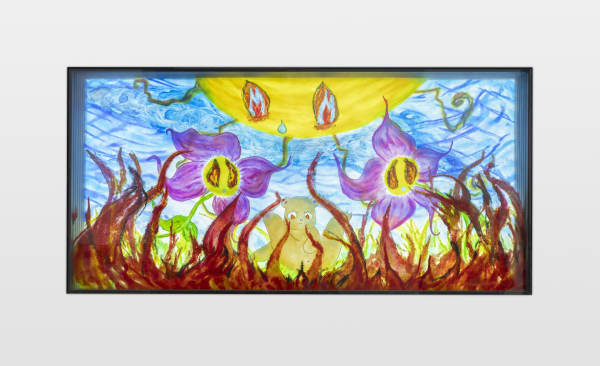It’s important to have ur fangs out at the end of the world Precious Okoyomon
A Mendes Wood DM tem o prazer de apresentar It’s important to have ur fangs out at the end of the world [É importante estar com as presas de fora no fim do mundo], a primeira exposição individual de Precious Okoyomon na galeria. A mostra reúne novas obras que traçam a exploração da artista sobre ecossistemas e sonhos e como os modos de relacionamento e pertencimento se figuram nessas imaginações alternativas. Através de uma instalação composta por papel de parede, desenhos, dioramas e ursos, Okoyomon encena mundos interiores oníricos onde o infantil e o erótico se tornam caminhos para compreender como a fragilidade pode ser uma condição radical de cuidado e transformação, enquanto a violência estrutural da vergonha sexual é desfeita com vitalidade e travessura. A artista escreveu uma nova fábula para esta exposição.
Se reduzíssemos a matéria à sua menor unidade, chegaríamos às partículas. A divisão mais infinitesimal, irredutível e inquieta. No entanto, tais unidades nunca existem em puro isolamento. Seu destino é relacional, perpetuamente ligado a campos frenéticos de forças vibrantes. Mesmo o elétron mais solitário sempre zumbirá dentro de uma teia de interações, como o primeiro indício de uma vasta floresta brotando em uma primavera fria, com a promessa de flores opulentas. Falar de partículas é falar da própria relação. Elas são o prólogo de todos os começos, um ecossistema onde nada existe sozinho. Em um nível, essa é a verdade física de que “nós” vem antes de “eu”, com a individuação ocorrendo em um contexto de relações.
Em sua trilogia Esferas, o filósofo Peter Sloterdijk abordou a mesma questão do individualismo a partir de uma perspectiva antropológica. Para Sloterdijk, os seres humanos são criaturas “esféricas”, inseridas em microesferas de intimidade e coexistência. Desde a bolha pré-natal do útero até os apegos da infância e os ambientes sociais e coletivos em que se vive, o eu é sempre co-construído com o outro. Se a física nos diz que as partículas só podem existir em relação, Sloterdijk sugere o mesmo para as bolhas da subjetividade.
Precious Okoyomon também apresenta bolhas redondas semelhantes a átomos como recipientes para intuições e impressões sobre o eu. As bolhas contêm olhos fofos e consternados que parecem tremer diante de seu destino poroso. Essas bolhas não apenas projetam uma abertura ilimitada do eu como sempre plural, mas também permitem uma jornada introspectiva que abraça a mesma natureza íntima da esfera. Aqui, notas maliciosas introduzem uma “Ilha do Prazer” de ursos desinibidos. Com olhos brilhantes, lábios lustrosos, roupas íntimas de renda de algodão e patas fofinhas, eles piscam de forma hilária, revelando um mundo interior onde o prazer reina voraz. Há algo perversamente infantil neles. Livres de tudo o que é reprimido, eles compõem suas fantasias. De leite, mel, flores e amor. Seus corpos tocam a terra, enquanto suas nádegas louvam o céu, totalmente abertas ao abandono. Vulneráveis, como seus orifícios superexpostos, mas protegidos da interação externa, seja com uma rede ou com o vidro de um diorama. Suas intimidades e visões eróticas softcore só podem ser observadas, não participadas.
Tal como o “objeto transicional” de Winnicott [1], os ursos da Okoyomon personificam o espaço entre a projeção da identidade e a transição para tudo o que existe fora dela. Tal como qualquer brinquedo fofinho pelo qual uma criança sente afeto, os ursos aqui se tornam uma ferramenta relacional. De certa forma, estes, sempre presentes no trabalho de Okoyomon, são uma prova de como cada um de nós se relaciona com o mundo exterior através de mundos interiores íntimos, que habitamos e de que dependemos, de modo que, esses mundos, por sua vez, mudam à medida que percorremos o mundo exterior. Não se trata de rejeitar a introspecção para agir na vida cotidiana, mas sim de nos orientarmos introspectivamente em direção ao nosso lugar mundo afora, com a certeza de que o eu é sempre plural. Assim, os traumas pessoais e históricos existem como feridas coletivas a serem conscientemente transformadas por meio da compaixão. Eles são abordados em paralelo ao colapso ecológico e à extração colonial, observando a resiliência da natureza como um modelo aplicável. A violência da história é internalizada conscientemente, no luto coletivo e na força empática do espírito.
A dimensão orgástica da prática de Okoyomon pode ser interpretada de várias maneiras. Há um elemento de desvio que rompe com a noção de inocência, mera construção religiosa, assim como qualquer representação pastoral da natureza distanciada da realidade, como só o ser humano pode estar. Há também um elemento de auto-obliteração no outro, ou abertura para o impulso destrutivo da natureza. A artista frequentemente demonstra seu amor por jardins venenosos que devoram tanto quanto nutrem. Ela encena ecossistemas desenfreados onde identidade, história colonial, espiritualidade, coletividade, objetos e o ambiente de vida se entrelaçam em sistemas que são constantemente criados e destruídos. A fragilização, uma noção emprestada da artista Bracha Ettinger, é central para a celebração de Okoyomon da condição de estar em relação, vulnerável à transformação e às forças destrutivas da natureza. Há violência, mas também libertação nessa fragilidade.
Há também uma sensação apocalíptica no conjunto, talvez reforçada tanto pelas referências religiosas quanto pela presença de chamas em alguns dos desenhos. É o Dia do Juízo Final. Uma conjunção com o céu, convenientemente o lugar favorito de Okoyomon. Do ponto de vista de uma partícula, qualquer ato de criação implica o fim do mundo.
Quanto ao livro da acadêmica Christina Sharpe, Ordinary Notes – outra referência importante para a artista –, onde a fragmentação se torna um método e uma proposta, uma alternativa para elaborar, oscilando entre crueldade e cuidado, tristeza e alegria, as obras de Okoyomon servem à sacralidade na confusão caótica do desejo, sob a lógica de que o amor é um exercício de fragilização, bem como um exorcismo. Uma pulverização em essência, um desapego.
— Claude Adjil
[1] O conceito de “objeto transicional” de Donald W. Winnicott (apresentado em Objetos transicionais e fenômenos transicionais, 1951, e posteriormente em O Brincar e realidade, 1971) descreve como objetos macios (como cobertores ou ursinhos de pelúcia) permitem à criança fazer a ponte entre a experiência psíquica interna e a realidade externa.










